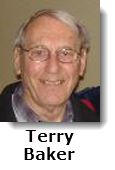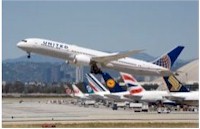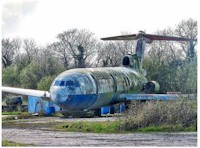|
|
|
Alcock and Brown return: Their statue has traveled almost as far over the decades as the intrepid aviators themselves, but Alcock and Brown have now landed for good at the Brooklands Museum in Surrey, England, where the aircraft that carried them across the Atlantic Ocean was built. A year alter the centenary of their non-stop flight, the sculpture was unveiled by Prince Michael of Kent, royal patron of the museum, in front of an audience of local dignitaries and family including the niece and nephew of Sir John Alcock. Originally situated in the old north side terminal at Heathrow Airport it was moved to the central area, then the now defunct visitors' centre, and finally the Heathrow academy. Last year, it went to the west of Ireland to mark the centenary. (Source: Flight International magazine issue March 3. 2020) |
|
Mothballed Widebodies Pressed Into Domestic Service.
Bean counters are busy doing the math to see where those aircraft, decked out with new entertainment systems and better cabin environments, might work more efficiently on the milk runs that make up the majority of flights. Parking a $400 million aircraft like a new B-777 is expensive and in the complex cost structure of airlines it can sometimes be less expensive to fly a big airplane with empty seats than to let it sit idle as a much less expensive B-737 or A320 flies full. An analysis by the newspaper showed American, Delta and United have all increased the use of intercontinental aircraft on two- to four-hour domestic routes. United will fly widebodies on almost 2700 domestic flights in April, up 54 percent over April of 2019, while American will boost their use by 37 percent and Delta will increase their domestic use by 73 percent. (Source: www.avweb.com/aviation-news |
|
Abandoned 1967 Hawker Siddeley Trident - Belfast, Northern Ireland
This 1967 Hawker Siddeley Trident passenger plane has been abandoned on the airport's fringes, and left to the ravages of time. (Source: MicroSoft News, November 6, 2019) This cylinder of sadness once serviced British Airways, and its royal blue coating still remains relatively bright, despite decades upon decades of neglect. Thanks to the famously rainy climate of the Emerald Isle, plenty of moss is thriving all across the shell of the plane, thoroughly frosting it in eerie stains of green. (Source: Instagram/irish aviation) Editor's note by Ken Pickford: Research indicates that aircraft is the former British Airways Trident 2E G-AVFE, delivered to predecessor British European Airways in 1968 and retired by British Airways in 1985, and subsequently used as a fire trainer at Belfast airport. |
|
Abandoned airports - Kal Tak - Hong Kong. Kai Tak International was Hong Kong’s main airport from 1925 to 1998, when it closed and all traffic moved to the new Hong Kong International Airport, 30 miles to the west. Surrounded by mountains and buildings, it was one of the world’s most notorious for take-offs and landings, especially on the famous track 13, since the aircraft had to make a turn of 90 or even 180 degrees. |
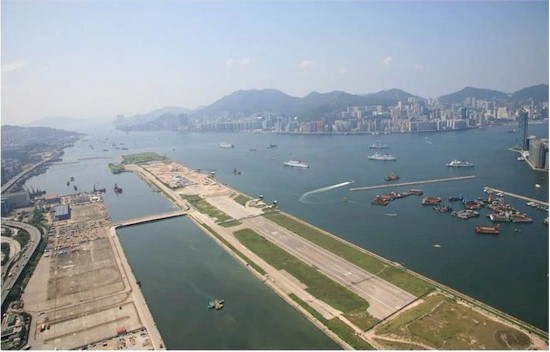 |
|
Subscriber J.K. Oakley (retired B-767 captain) sends in the following personal request: I am researching Canadian Army Pilots of WWII. G.B. (Bus) Duhamel was one of the select few. After the war he joined TCA and I have found references to him being the general/group sales manager in YUL in the 50's to mid 60's. After that he moved to the Chicago area. I would like to know if anyone remembers if he was still employed by Air Canada at ORD, and in what capacity? |
|
|
Twenty seven years ago Air Canada leased Boeing 767's to Polynesian Airlines of Western Samoa, now called just Samoa. The first aircraft was fin # 618 that was flown by Air Canada line pilots, the Chief Pilot being Captain Alan McLeod from the Dorval (YUL) base. The original flight attendants were from Air Canada, but after flight attendants from Polynesian were trained to Transport Canada standards in Montreal they then acted as cabin attendants. The aircraft flew from Apia in Samoa to Los Angeles (LAX) via Honolulu (HNL) and on the return landed in the Cook Islands before going on to Samoa. The southern route was to Tonga and Auckland (AKL) before terminating at Sydney (SYD). Northbound the flight was via Nadi, Fiji and on to Apia. With the arrival of the first B-767-300 to the Air Canada fleet in 1993 it was decided that this machine, fin 631 (C-FMWP) would be painted in Polynesian colours and replace 618 as it was the first 300 series and did not fit into the fleet. It was an attractive paint scheme with a large palm tree on the tail large letters reading " POLYNESIAN " and the name "Manu Samoa" painted on the nose. ("Big Samoan"). We were approximately fifteen pilots from the three B-767 bases under direction of "Base Director" Captain Alan McCleod. Our resident engineer was Robert Brown, AME from YVR (later Maintenance Manager). We all had a lovely time down in Samoa however eventually Polynesian ran into financial difficulties and the lease was cancelled and the aircraft was returned to the line in Canada. The flight home was non-stop, Apia to Toronto (YYZ), a distance of 6,050 nautical miles and took 14 hours. While most of us partied in the back, those who did not take a sip, took turns flying the machine for the long haul by standards of those days. The designated captain for the flight was able to come aft after take off and joined us for a bit as it was over 12 hours before he would return to the cockpit to land. In the photos are the pilots in Samoan "Lavalavas" the traditional men's dress in Samoa. Alan McCleod is pictured on the bottom of the stairs in front of fin 618 and shown again in front of the engine with Bob Brown on his right, who is not wearing a cap. F/O Paul Stenner (retired) Editor's note: Fin # 631 (pictured in this issue's header) is now 27 years old and still active within the Rouge fleet. |
|
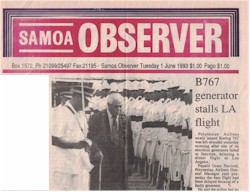 |
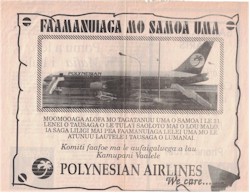 |
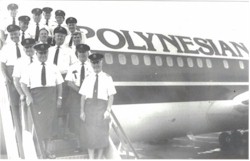 |
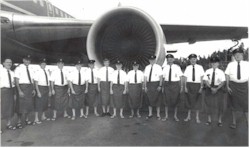 |
|
Subscriber Aaron Plaxton sends his comments on the Nordair 'Featured Video' article from NL # 1432 My father, Wayne Plaxton was the first Station Manager in Winnipeg (YWG) when Nordair made its first foray out of the East. He later was Station Manager for Frobisher Bay (now Iqaluit), (YFB) following the strike. When CP bought the company he was, I believe, the first Manager to transfer to a western base, settling until retirement in Calgary (YYC). I also worked for Nordair, first as a Summer Student in YFB in Cargo / Ramp then becoming full time. I transferred to Toronto (YYZ) when we became Canadian Airlines to Cargo and ended my stint with the company at Vancouver (YVR) where I resigned to another career after 14 years at the company. Loved all the videos and know many of the people in them. Cheers, Aaron Plaxton |
|
|
Steve Davis sends this – Thanks for the latest edition of NetLetter #1432, always an enjoyable read. I'm puzzled by the picture sent in by Peter Brown of his time at building 107, (which I knew well as my LHR employer was also located there). AC Cargo LHR in which there are twelve personnel pictured but only ten mentioned. Included in the list is a 'Barbara Walters' but there is clearly no female in that picture, only males. Peter also makes mention of a 'Ray West'. While it is quite possible that he refers to a different Ray West, I do not recognize the Ray West I knew in that picture. I was friendly with Ray West who was an LHR based AC Area Sales Manager around that time and it was Ray who presented me & my wife AC passes to YYZ when we emigrated to Canada in 1974. Perhaps Peter could clarify if he's posted the right picture or if indeed he has another one, given the discrepancies? I last saw Ray in Toronto around 1976/77 when quite coincidentally we found ourselves walking towards each other on a downtown crosswalk. We had a long chat over a coffee then went our separate ways. I learned from someone on the ramp at YYZ about 20+ years ago that 'my' Ray West had died a couple of years before then. Ray was a great guy and typical of the really colourful characters that made up the airline cargo sales forces at Heathrow in the late sixties & early seventies! Here's hoping Peter Brown can confirm. Cheers, Steve Davis ex Wardair Cargo Sales Manager YYZ We, at the NetLetter responded to Steve - We are happy to know that you enjoy our efforts with the NetLetter. The list of names that Peter mentioned were the people he recalls working at the time in LHR when he worked there. The group photo is the Air Canada people working on the Cabbage Patch project and, as you point out, does not accurately represent the people listed. |
|

